I believe that your issue is not that your triggers are wrong in theory BUT that you have 3 tables:-
- TABLE1,
- TABLE2 and
- BN_MS_LS_SCHEDULE
and you are getting the row count from TABLE2 but inserting into BN_MS_LS_SCHEDULE.
This answer is based upon 12 inserts into table 1 triggering 12 times, rather the interpreting After insert on TABLE 1 a trigger should be called 12 times and insert 12 rows as meaning that 12 rows should be inserted when the first row in table1 is inserted, if this is the requirement then you could :-
- either use a single INSERT with mutlitple sets of values e.g.
INSERT INTO BN_MS_LS_SCHEDULE (column1,column2) VALUES('001','002'),('003','004') ......
- or use 12 INSERT statements/actions within the BEGIN .... END construct (the given example shows such multiple (2) statements/actions)
At a guess you need to do something like :-
public void onCreate(SQLiteDatabase db) {
createTables(db);
db.execSQL("CREATE TRIGGER multi_insertion AFTER INSERT ON TABLE1 " +
" WHEN (SELECT COUNT (*) from TABLE2 where MYNUMBER=1) < 12" +
" BEGIN " +
" INSERT into BN_MS_LS_SCHEDULE (COLUMN1,COLUMN2) VALUES ('001','002');" +
" INSERT into TABLE2 VALUES(?????????); " + //<<<<<<<<< insert a row into table 2 to act as a counter
" END;");
}
Example
Consider this working example based upon what can be gleaned from your code, with an exception that table2 has had an additional column added which is used to record a value from table1 into table1, thus showing how you can use new.column within a TRIGGER.
DROP TABLE IF EXISTS table1;
DROP TABLE IF EXISTS table2;
DROP TABLE IF EXISTS BN_MS_LS_SCHEDULE;
DROP TRIGGER IF EXISTS multi_insertion;
CREATE TABLE IF NOT EXISTS table1 (mydata);
CREATE TABLE IF NOT EXISTS table2 (mynumber,valuefromtable1);
CREATE TABLE IF NOT EXISTS BN_MS_LS_SCHEDULE (COLUMN1,COLUMN2,OTHERCOLUMNS);
CREATE TRIGGER IF NOT EXISTS multi_insertion
AFTER INSERT ON table1
WHEN (SELECT COUNT (*) from TABLE2 where MYNUMBER=1) < 12
BEGIN
INSERT INTO table2 VALUES(1,new.mydata /* record value that caused insert */); /*<<<<<<<<<< ADDED TO TRIGGER >>>>>>>>>>*/
INSERT into BN_MS_LS_SCHEDULE (COLUMN1,COLUMN2) VALUES ('001','002');
END;
/* Add some testing data which will exceed the 12 rows */
INSERT INTO table1 VALUES('a');
INSERT INTO table1 VALUES('b');
INSERT INTO table1 VALUES('c');
INSERT INTO table1 VALUES('d');
INSERT INTO table1 VALUES('e');
INSERT INTO table1 VALUES('f');
INSERT INTO table1 VALUES('g');
INSERT INTO table1 VALUES('h');
INSERT INTO table1 VALUES('i');
INSERT INTO table1 VALUES('j');
INSERT INTO table1 VALUES('k');
INSERT INTO table1 VALUES('l');
INSERT INTO table1 VALUES('m');
INSERT INTO table1 VALUES('n');
INSERT INTO table1 VALUES('o');
INSERT INTO table1 VALUES('p');
INSERT INTO table1 VALUES('q');
INSERT INTO table1 VALUES('r');
/* Results */
SELECT * FROM table1;
SELECT * FROM table2;
SELECT * FROM BN_MS_LS_SCHEDULE;
/* Cleanup Text Environment */
DROP TABLE IF EXISTS table1;
DROP TABLE IF EXISTS table2;
DROP TABLE IF EXISTS BN_MS_LS_SCHEDULE;
DROP TRIGGER IF EXISTS multi_insertion;
Results
Running the above results in :-
Table1 i.e. with all 18 rows that were inserted.

Table2

- THe highlighted column shows data retreived from table 1
- as can be seen 12 rows only have been added
BN_MS_LS_SCHEDULE

- Likewise only 12 rows have been addded


